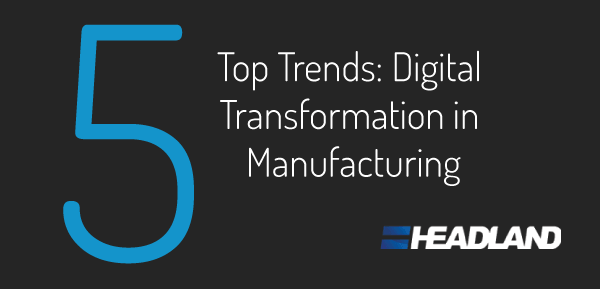Digital Transformation in Manufacturing
First the industrial revolution had its impact on manufacturing, now digital transformation in manufacturing is rapidly changing the industry. Manufacturing companies are using technology to move from mass production to customised production, and it’s happening fast.
The digitisation of manufacturing is being driven by consumer expectations and connected devices and platforms. The majority of manufacturing executives acknowledge the importance of digital manufacturing, however only 5% say they’re satisfied with their current digital strategies. We’ve compiled the top five trends within digital transformation in manufacturing.
1. Internet of Things (IoT) and Industry 4.0
IoT continues to give companies the all-important competitive edge by streamlining and simplifying manufacturing processes with connected technology.
By providing real-time feedback and information, businesses are better informed to make decisions and reduce manual processes. Industry 4.0 is said to represent the vision of the interconnected factory where equipment is online, and is also intelligent and capable of making its own decisions.
The trend of mass customisation enables manufacturers to efficiently cater for consumer demand. Nowadays, customers expect the products they use to be intuitive, so connectedness drives manufacturers to innovate faster and create software-enabled products.
Read our cheat sheet.
2. AI and Machine Learning
Smart factories with integrated IT systems make it easier to provide information to both sides of the supply chain, increasing production capacity by 20%.
Efficiency and quality are both of prime importance, and there is less time wasted with manual processes as well as increased accuracy and workflow.
Simply put, with the industry becoming more digital, costs of production are lower, turnarounds are quicker, and customer demand is met more efficiently.
3. Robots
In the past, robots are known to have performed tedious and repetitive tasks on the assembly line.
They have become increasingly used in the manufacturing industry as they are easy to train, and are making workplace environments safer for humans, by taking their place in potentially dangerous situations.
Furthermore, robots equipped with sensors can also provide valuable feedback and data – so they can “talk” to the control board, identifying and fixing issues, increasing efficiency and minimising any delays.
4. Speed and Efficiency
Automated technology and robots are crucial for manufacturing businesses to improve speed and efficiency. I
ntegrated IT systems, your teams across geographical locations can access the relevant data they need, facilitating faster, collaborative communication.
Due to this, an increased number of manufacturers are implementing cloud software. If you’d like more information on cloud software, our sister company Klugo can help.
5. Data and Analytics
By 2020, experts predict that there will be 50 times the digital content in comparison to what currently exists today.
Big data analysis is difficult and time consuming; with managing, updating, and analysing consumer and product information.
Manufacturers are favouring cloud technology thanks to its ability to streamline data, allow for collaboration and increased visibility for all stakeholders.
Today, we’ve grown accustom to the immediacy of IoT, so consumers and production teams expect the same from both products and processes – requiring innovation from manufacturers.
Feel free to get in touch for more information.

